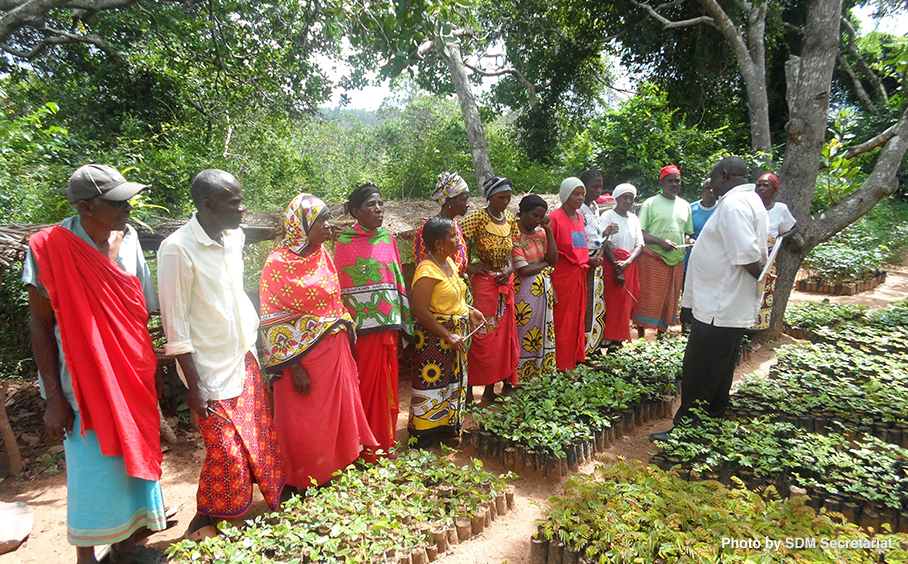
Aerial view of Baa Atoll, the Maldives by dorada000001 via FREEPIK
Issue
The Maldives faced the challenge of visualizing climate change risks and identifying pathways for mitigating and adapting to various hydrometeorological hazards. The majority of available open-source climate data were too coarse, with grids as large as 100 kilometers, making it difficult to capture local climate variations across the small islands scattered throughout a vast area.
Solution
To obtain more detailed data, the United Nations Economic and Social Commission for Asia and the Pacific (ESCAP) collaborated with AP-PLAT, which provided climate projection data downscaled to a 5-kilometer grid, enabling assessment tailored to local conditions.
Overview
As part of the joint project titled “Strengthening National and Subnational Capacity for Sustainable Disaster Risk Reduction, Climate Change Adaptation and Mitigation in Maldives,” funded by the Sustainable Development Goals Fund (SDG Fund), ESCAP is identifying climate risk hotspots and assessing the vulnerabilities of climate-sensitive sectors in the Maldives concerning climate-related hazards. The Maldives, a small, low-lying island nation, is regularly exposed to various hydrometeorological hazards. To mitigate these threats, it is crucial to visualize the risks and plan for adaptation and mitigation pathways.
Most of the open-source global data, such as the IPCC data, is limited by its coarse resolution, with a grid size of 100 km, making them unsuitable for capturing the local nuances in climate variability. This limitation is particularly pronounced in small island nations like the Maldives, where many islands have an area of less than 10 square km. Hence, there was a critical need for downscaled climate projections to better understand sub-national risks.
To address this challenge, ESCAP collaborated with AP-PLAT to downscale the climate projection data to a 5 km grid for the Maldives. This downscaled data significantly improved the climate risk assessment in the Maldives by providing detailed information on the spatial variability of climate variables at the atoll and island levels. The downscaled data for the baseline period (1981-2000) and two climate change scenarios (SSP2 4.5 and SSP3 7.0) for both near-term (2021-2040) and mid-term (2041-2060) periods were used to identify climate risk hotspots. The visualization of all the analysis is available on the ESCAP Risk and Resilience Portal – Maldives Decision Support Tool.
FIGURE: SPATIAL DISTRIBUTION

The figure shows spatial distribution of (A) multi-hazard, (B) total annual precipitation, (C) average annual temperature, and (D) seasonal average surface wind, under baseline and climate change scenarios.
KEY FINDINGS
The following are the key findings:
• Multi-Hazard Risks: The risk of multi-hazards, including intensified precipitation, flood-like situations, increased temperature, water scarcity, high surface wind, cyclonic winds and storms, and sea level rise is on the rise across the country. However, the northern and central atolls are expected to experience multi-hazard events with higher intensity compared to the southern atolls, irrespective of the climate change scenario (Figure A).
• Precipitation Increase: The central atolls are projected to receive the highest total annual precipitation across all scenarios, with some areas experiencing up to a 100 mm increase from the baseline. An analysis of flood events shows that many islands in these atolls have already been grappling with rainwater-related flood situations over the past decade (Figure B).
• Temperature Rise: Average annual temperatures are likely to rise nationwide, with more increase (up to 1.6 °C) occurring in the northern and central atolls by 2040 under the SSP2 4.5 scenario. Under the SSP3 7.0 scenario, average annual temperatures may increase by up to 1.7 °C in all atolls by the end of 2060, except for the southern-most atolls, thereby elevating the risk of of drought and water scarcity (Figure C).
• Seasonal Wind Trends: Future trends in seasonal surface winds during the wet season from May to October follow the baseline trends. These predict that the highest wind speeds are anticipated in the northern atolls, with a higher likelihood of cyclone and storm-like events across all scenarios. In contrast, the southern and central atolls are expected to maintain a situation similar to the baseline until end of 2060.
PROJECT INFORMATION
Project Name: Strengthening National and Subnational Capacity for Sustainable Disaster Risk Reduction, Climate Change Adaptation and Mitigation in Maldives
Funding: The project is funded by the United Nations Sustainable Development Goals Fund (UN SDG Fund), with a total budget of USD 957,390.
Implementation Entities: The project is jointly implemented by ESCAP and UNDP Maldives in partnership with the Maldives National Disaster Management Authority and the Ministry of Environment, Climate Change and Technology (Maldives Met Service).
Duration: January 1, 2022, to March 31, 2024 (27 months).
ACKNOWLEDGEMENTS
We extend our appreciation to the United Nations Economic and Social Commission for Asia and the Pacific (ESCAP) for their generous provision of this case study to the database.
Related Information
- Project overview: Strengthening National and Subnational Capacity for Sustainable Disaster Risk Reduction, Climate Change Adaptation and Mitigation in Maldives.
- United Nations Economic and Social Commission for Asia and the Pacific (ESCAP)
- United Nations Development Programme (UNDP)
- Sustainable Development Goals Fund (SDG Fund)
- ESCAP Risk and Resilience Portal - Maldives Decision Support Tool - Analysis Visualization
- Related case study: Climate Exposure Analysis Using AP-PLAT Data in the Maldives
KEYWORDS
- # Case Study
- # Agriculture
- # Coastal Areas
- # Energy
- # Human Health
- # Infrastructure
- # Life of Citizenry and Urban Life
- # Natural Disasters
- # Tourism
- # Adaptation Planning/Policy
- # Climate Projection
- # Disaster Prevention/Disaster Mitigation
- # Impact Assessment/Risk Assessment
- # International Cooperation
- # Asia
- # Maldives
- # 2023




